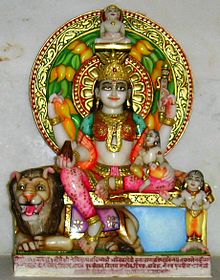Isakki
This article needs additional citations for verification. (July 2018) |

Isakki (Tamil:இசக்கி) (Sanskrit:इसक्कि) (IAST:isakki) or Isakkai is a Hindu Goddess. The term Isakki derived from Sanskrit Yakshi through Prakrit Yakki. Worshipping her remains popular among Hindus in the southern Indian districts of Tamil Nadu,[1] specifically the Kanyakumari, Tirunelveli and Salem districts. She is generally considered to be one of the 'village deities' (or kaaval deivam (காவல் தெய்வம்) in Tamil) and is commonly referred to as "Isakki Amman" ('Amman' is Tamil for "mother"). Village deities are believed to act as guardian spirits.[2][1]
Iconography[]

Isakki is usually portrayed as a young woman wearing a red dress. She is usually represented by holding a child in one hand and a trident in the other. She is also sometimes represented as standing above a man who lies on the ground.[3] Isakki corresponds to the Jain Yakshini Ambika, who is always represented together with one or two children under a tree.[4][3]
Legend[]
The most common legend associated with Isakki is as follows: Ambika, a housewife, was leading a peaceful family life with her husband Somasharman and their two sons. One day the "Darpaņam" ritual had to be performed for the ancestors of their family and all the items were duly prepared. However, while Somasharman was away to bathe in the river, Ambika offered food to a starving sage who begged for it. Somasharman became enraged that the food for the ritual offering had been served to the sage before the necessary rites and pujas, and he chased Ambika and her children away from home. Ambika wandered until she found a calm place to rest. Realising his foolishness later, Somasharman went in to search his wife and children, but fearing him, Ambika gave up her life. After her unfortunate death, it is believed that she took the form of a Yakshini, although she still wanted to take care of her growing children. Later, she was able to regain her life for the benefit of her offspring. In doing so, Ambika became the Goddess, Isakki.
Shrines[]
Unlike the temples of the Vedic deities, temples dedicated to Isakki are usually humble shrines decorated with a cactus-like plant known as paalkalli in Tamil. When it is damaged, these cacti ooze a milk-like sap which is considered to be a sign of the goddess Isakki.
Isakki temples usually have a Banyan or bo tree located close to the shrine. Women who wish to have children often place small wooden cribs and/or tie pieces of their saris to the branches or the visible roots of the tree as an offering.
Festivals[]
Isakki Amman is associated with popular festivals that involve cooking food at the shrine and the dedication of large terracotta figures of the goddess (3 to 4 ft in height) painted in bright colors. During the festival, the deities are anointed with water, coconut milk, rosewater, honey or oil twice a day. These figures are sometimes smeared with a liquid made from mixing lime, water and turmeric (which ritually represents blood). The goddess is then offered rice, cake, fruit, milk while the presiding priest chants prayers. At the end of the ceremony and festival, the food is removed from the shrine.[1]
References[]
- Kalpana Ram; Mukkuvar Women.
- Xavier Romero-Frias, The Maldive Islanders, A Study of the Popular Culture of an Ancient Ocean Kingdom. Barcelona 1999.
- Tiwari, M.N.P. (1989). Ambika in Jaina arts and literature, New Delhi: Bharatiya Jnanpith.
- ^ a b c Tisak Kiamman, A aprotector of Ecology and Culture of Kanyakumari
- ^ "Arulmigu Devi Sri Isakki Amman Thirukovil, OrappanavilaiSaral". Retrieved 14 November 2018.
- ^ a b The Classical Period of Indian Art :Gupta Art http://www.indianartcircle.com/arteducation/page_7_gupta.shtml
- ^ Inscribed stele with the yakshi Ambika https://www.britishmuseum.org/explore/highlights/highlight_objects/asia/i/inscribed_stele_with_the_yaksh.aspx
External links[]
![]() Media related to Isakki at Wikimedia Commons
Media related to Isakki at Wikimedia Commons
- Regional Hindu goddesses
- Tamil deities
- Health goddesses